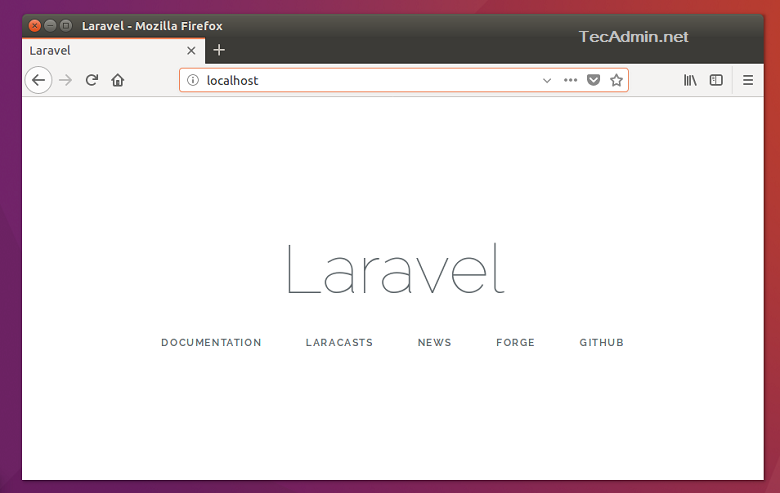Laravel is one of the best open-source, MVC PHP framework, designed for the faster development of web applications. You can simply install and use on your development system. This article will help you to install the Laravel PHP Framework on Debian 10 (Buster) Linux system.
Laravel requirements
- Apache
- MySQL/MariaDB
- PHP >= 7.1.3
- OpenSSL PHP Extension
- PDO PHP Extension
- Mbstring PHP Extension
- Tokenizer PHP Extension
- XML PHP Extension
Step 1 – Prerequsiteis
You need to install the recommended PHP version with the required modules before starting the Laravel installation. The system has already running LAMP stack skip this step else use the following commands to set up the lamp on Debian 10 system.
Install PHP 7
sudo apt-get install git python-software-properties wget -q https://packages.sury.org/php/apt.gpg -O- | sudo apt-key add - echo "deb https://packages.sury.org/php/ buster main" | sudo tee /etc/apt/sources.list.d/php.list
sudo apt update sudo apt install php php-mcrypt php-gd php-mbstring php-xml
Install Apache2
sudo apt install apache2 libapache2-mod-php
Install MySQL
sudo apt install mysql-server php-mysql
Install PHP Composer
The composer is required for installing Laravel dependencies. So use the below commands to download and use as a command in our system.
curl -sS https://getcomposer.org/installer | php sudo mv composer.phar /usr/local/bin/composer sudo chmod +x /usr/local/bin/composer
Step 2 – Installing Laravel on Debian
Clone the latest Laravel source code from its official git repository to your local system. Just execute the following command to do it.
cd /var/www git clone https://github.com/laravel/laravel.git
Navigate to the Laravel code directory and use the composer to install all dependencies required for the Laravel framework.
cd /var/www/laravel sudo composer install
The dependencies installation may take some time as per your network speed. After successfully installing all dependencies, set the proper permissions on all files.
chown -R www-data.www-data /var/www/laravel chmod -R 755 /var/www/laravel chmod -R 777 /var/www/laravel/storage
Step 3 – Set Encryption Key
Now, rename the .evn.example file to .env in projects main directory. This will use to setup application environment for the project.
mv .env.example .env
Then, generate base64 random number encryption key, which used by the Illuminate encrypter service.
php artisan key:generate Application key set successfully.
Edit the .env configuration file and update the required settings. Also, make sure APP_KEY is properly set as generated in above command.
vi .env
APP_NAME=Laravel APP_ENV=local APP_KEY=base64:Wer9JfZHN4qYQt9i8Hn1hLt8LWPeT3urzdI0hVqfzJM= APP_DEBUG=true APP_URL=http://localhost
Step 4 – Setup MySQL Database
You may also require creating a database for your Laravel application. Login to your MySQL server and create MySQL database and user.
1 2 3 4 | mysql> CREATE DATABASE laravel; mysql> GRANT ALL ON laravel.* to 'laravel'@'localhost' IDENTIFIED BY 'secret_password'; mysql> FLUSH PRIVILEGES; mysql> quit |
Edit the .env file and update database settings.
DB_CONNECTION=mysql DB_HOST=127.0.0.1 DB_PORT=3306 DB_DATABASE=laravel DB_USERNAME=laravel DB_PASSWORD=secret_password
Step 5 – Apache Configuration
You can create a new Apache configuration file or edit Apache default virtual host configuration file 000-default.conf and update DocumentRoot to Laravel public directory as below.
vim /etc/apache2/sites-available/000-default.conf
Update configuration as:
<VirtualHost *:80>
ServerAdmin webmaster@localhost
DocumentRoot /var/www/laravel/public
<Directory />
Options FollowSymLinks
AllowOverride None
</Directory>
<Directory /var/www/laravel>
AllowOverride All
</Directory>
ErrorLog ${APACHE_LOG_DIR}/error.log
CustomLog ${APACHE_LOG_DIR}/access.log combined
</VirtualHost>
Reload Apache configuration changes by restarting service using below command
sudo service apache2 restart
Step 6 – Access Laravel Application
Finally, Laravel PHP framework has been successfully configured on your Debian 10 Buster Linux system. Access Laravel application in your favorite web browser as below:
Let’s start building an awesome application using Laravel PHP Framework.
Happy coding!


2 Comments
Excellent.
All good, however, the version of laraver that was installed was 4.0.0
I have Debian 10 and the steps outlined here worked perfectly.
Any comment? to have more recent versions of laravel
Nice, could you also explain how to access the Laravel App on RaspberryPi from another computer?